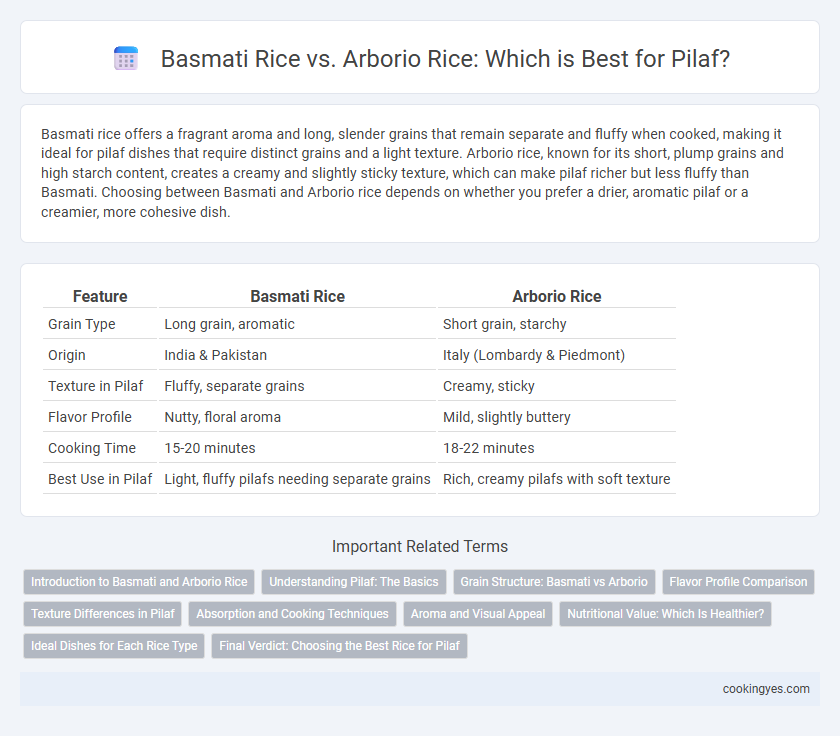Basmati rice offers a fragrant aroma and long, slender grains that remain separate and fluffy when cooked, making it ideal for pilaf dishes that require distinct grains and a light texture. Arborio rice, known for its short, plump grains and high starch content, creates a creamy and slightly sticky texture, which can make pilaf richer but less fluffy than Basmati. Choosing between Basmati and Arborio rice depends on whether you prefer a drier, aromatic pilaf or a creamier, more cohesive dish.
Table of Comparison
| Feature | Basmati Rice | Arborio Rice |
|---|---|---|
| Grain Type | Long grain, aromatic | Short grain, starchy |
| Origin | India & Pakistan | Italy (Lombardy & Piedmont) |
| Texture in Pilaf | Fluffy, separate grains | Creamy, sticky |
| Flavor Profile | Nutty, floral aroma | Mild, slightly buttery |
| Cooking Time | 15-20 minutes | 18-22 minutes |
| Best Use in Pilaf | Light, fluffy pilafs needing separate grains | Rich, creamy pilafs with soft texture |
Introduction to Basmati and Arborio Rice
Basmati rice, known for its long slender grains and aromatic fragrance, originates from the Indian subcontinent and is prized for its fluffy, separate grains when cooked, making it ideal for pilaf recipes. Arborio rice, originating from Italy, features short, plump grains with a high starch content that create a creamy texture, traditionally used in risotto but sometimes adapted for richer, creamier pilaf dishes. Understanding the distinct grain size, texture, and starch composition of Basmati and Arborio rice helps determine the best choice for pilaf based on desired consistency and flavor profile.
Understanding Pilaf: The Basics
Basmati rice, with its long grains and aromatic profile, absorbs flavors well and remains fluffy, making it ideal for a traditional pilaf that requires separate, distinct grains. Arborio rice, being short-grain and starchy, tends to release more starch and becomes creamy, better suited for risotto rather than pilaf. Understanding pilaf's basics highlights the importance of grain texture and moisture absorption, where Basmati rice excels in maintaining grains separate and aromatic throughout cooking.
Grain Structure: Basmati vs Arborio
Basmati rice features long, slender grains with a firm, dry texture ideal for fluffy pilaf where individual grains remain separate. Arborio rice has short, plump grains with a high starch content, resulting in a creamy and sticky consistency better suited for risotto than pilaf. Choosing Basmati rice enhances pilaf by maintaining distinct, non-clumpy grains.
Flavor Profile Comparison
Basmati rice offers a fragrant, nutty aroma with long, slender grains that remain fluffy and separate when cooked, making it ideal for pilaf with a delicate, aromatic flavor. Arborio rice features shorter, plumper grains with a creamy, starchy texture and a mild, slightly sweet taste, producing a richer, more velvety pilaf. The choice between Basmati and Arborio rice influences the pilaf's flavor profile, with Basmati providing fragrant lightness and Arborio delivering a creamy, smooth mouthfeel.
Texture Differences in Pilaf
Basmati rice has long, slender grains that remain separate and fluffy when cooked, making it ideal for pilaf dishes that require a light, airy texture. Arborio rice, with its short, round grains and high starch content, produces a creamier and stickier texture, which can result in a denser pilaf consistency. For pilaf recipes that emphasize distinct grain separation and a dry finish, Basmati rice is the preferred choice over Arborio.
Absorption and Cooking Techniques
Basmati rice, known for its long grains and fluffy texture, absorbs water gradually, making it ideal for pilaf recipes that require separate, non-sticky grains. Arborio rice has a higher starch content, resulting in a creamier texture and increased water absorption, which is perfect for risotto but less suitable for traditional pilaf dishes. Cooking techniques for basmati involve rinsing and soaking to reduce starch and ensure fluffiness, while arborio rice often requires constant stirring to release starch and achieve its signature creaminess.
Aroma and Visual Appeal
Basmati rice offers a distinctive, fragrant aroma and long, slender grains that create an elegant, fluffy pilaf with a visually appealing separation of grains. Arborio rice, known for its short, plump grains and creamy texture, lacks the aromatic profile that defines basmati but adds a rich, glossy appearance to dishes. The choice between basmati and arborio rice for pilaf depends on whether a fragrant, light pilaf or a creamy, visually dense dish is preferred.
Nutritional Value: Which Is Healthier?
Basmati rice contains fewer calories and has a lower glycemic index compared to Arborio rice, making it a better choice for blood sugar control and weight management. Arborio rice, commonly used in risottos and pilafs, has higher amylopectin content, providing a creamier texture but with higher carbohydrates and slightly less fiber. For a healthier pilaf option, Basmati rice offers more dietary fiber, essential nutrients like magnesium and B vitamins, supporting better digestion and metabolic health.
Ideal Dishes for Each Rice Type
Basmati rice, with its long grains and aromatic, fluffy texture, is ideal for pilaf dishes that include spices, herbs, and vegetables, commonly found in Indian and Middle Eastern cuisine. Arborio rice, short and starchy, is perfect for creamy pilafs that require a tender, chewy texture, such as risotto-style pilafs or Italian-inspired recipes. Using Basmati enhances dishes with separate, non-sticky grains, while Arborio delivers a rich, creamy consistency suitable for slow-cooked, saucy pilafs.
Final Verdict: Choosing the Best Rice for Pilaf
Basmati rice offers a fluffy, separate grain texture ideal for traditional pilaf recipes, while Arborio rice provides a creamier, stickier consistency better suited for risottos but less ideal for pilaf. For pilaf, Basmati's long grain and fragrant aroma enhance flavor and presentation, making it the preferred choice. The final verdict favors Basmati rice due to its superior texture and taste compatibility with pilaf dishes.
Basmati Rice vs Arborio Rice for Pilaf Infographic

 cookingyes.com
cookingyes.com